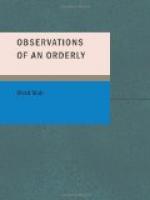The best part of our hospital—the hospital, to most of us—came into being when the commandeered Scottish baronial orphans’ asylum was found to be too small. Then were built “the huts.”
The word “hut” suggests something casual, of the camping-out order: a shed knocked together with tin-tacks, doubtfully weather-proof and probably scamped by profiteering contractors. Of the huts provided at certain training centres this may have been true. The finely austere and efficient ranks of hut-wards which constitute the main part of the 3rd London General Hospital are the very antithesis of that picture. They may look flimsy. They were certainly put up at a remarkable pace. I myself witnessed the erection of the final fifty of them. An open field vanished in less than a month, and “Bungalow Town” (as someone nicknamed it) appeared. You would have said that such speed meant countless imperfections of detail. No doubt some tinkerings and modifications were bound to follow, when the regiment of workmen, carpenters, engineers, drainage specialists, electricians, had vanished. But, in the long run, the ideal hospital remained—a hospital with which the So-and-So Club in Pall Mall, for all its luxuriousness, could never hope to compare.
There are still a dozen wards—used mostly for medical cases—in the Scottish baronial building. Its rooms, too, provide the Administration with offices. Its great Dining Hall is a splendid Receiving Ward for the sorting-out and clearance of newly-arrived convoys of patients. We should be poorly situated indeed if we had not our Scottish baronial main building to be the hub of the hospital’s activities, or rather the handle from which springs the fan of the hospital’s great extension—the huts. Approaching the hospital the visitor sees nothing of those huts. As he walks up the drive he flatters himself that he has reached his destination. He discovers his mistake when, at the inquiry bureau in the entrance, he is informed that the patient whom he has come to interview is (say) in “C 13.” He is advised to go down the passage on his left, turn to his right, turn to the left again and then again to the right—after which he had better seek a further re-direction. Launching himself optimistically on this voyage he learns, long ere he has attained his goal, that a modern war-hospital can hide a considerable extent of pedestrianism behind a comparatively short Scottish baronial frontage. He will be fortunate if five minutes’ steady tramping brings him to the bedside of his friend in C 13.




